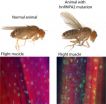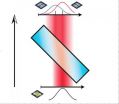(Press-News.org) March 3, 2013— (Bronx, NY) — Researchers at Albert Einstein College of Medicine of Yeshiva University have discovered how the most common genetic mutations in familial Parkinson's disease damage brain cells. The study, which published online today in the journal Nature Neuroscience, could also open up treatment possibilities for both familial Parkinson's and the more common form of Parkinson's that is not inherited.
Parkinson's disease is a gradually progressing disorder of the nervous system that causes stiffness or slowing of movement. According to the Parkinson's Disease Foundation, as many as one million Americans are living with the disease.
The most common mutations responsible for the familial form of Parkinson's disease affect a gene called leucine-rich repeat kinase-2 (LRRK2). The mutations cause the LRRK2 gene to code for abnormal versions of the LRRK2 protein. But it hasn't been clear how LRRK2 mutations lead to the defining microscopic sign of Parkinson's: the formation of abnormal protein aggregates inside dopamine-producing nerve cells of the brain.
"Our study found that abnormal forms of LRRK2 protein disrupt an important garbage-disposal process in cells that normally digests and recycles unwanted proteins including one called alpha-synuclein – the main component of those protein aggregates that gunk up nerve cells in Parkinson's patients," said study leader Ana Maria Cuervo, M.D., Ph.D., professor of developmental and molecular biology , of anatomy and structural biology , and of medicine and the Robert and Renee Belfer Chair for the Study of Neurodegenerative Diseases at Einstein.
The name for the disrupted disposal process is chaperone-mediated autophagy (the word "autophagy" literally means "self-eating"). It involves specialized molecules that "guide" old and damaged proteins to enzyme-filled structures called lysosomes; there the proteins are digested into amino acids, which are then recycled within the cell.
"We showed that when LRRK2 inhibits chaperone-mediated autophagy, alpha-synuclein doesn't get broken down and instead accumulates to toxic levels in nerve cells," said Dr. Cuervo.
The study involved mouse neurons in tissue culture from four different animal models, neurons from the brains of patients with Parkinson's with LRRK2 mutations, and neurons derived from the skin cells of Parkinson's patients via induced pluripotent stem (iPS) cell technology. All the lines of research confirmed the researchers' discovery.
"We're now looking at ways to enhance the activity of this recycling system to see if we can prevent or delay neuronal death and disease," said Dr. Cuervo. "We've started to analyze some chemical compounds that look very promising."
Dr. Cuervo hopes that such treatments could help patients with familial as well as nonfamilial Parkinson's – the predominant form of the disease that also involves the buildup of alpha-synuclein.
Dr. Cuervo is credited with discovering chaperone-mediated autophagy. She has published extensively on autophagy and its role in numerous diseases, such as cancer and Huntington's disease , and its role in age-related conditions, including organ decline and weakened immunity. Dr. Cuervo is co-director of Einstein's Institute of Aging Research.
### The paper is titled "Interplay of LRRK2 with chaperone-mediated autophagy." In addition to Dr. Cuervo, other Einstein contributors include Samantha J. Orenstein, a graduate student who performed most of this study as part of her Ph.D. thesis; Inmaculada Tasset, Ph.D.; Esperanza Arias, Ph.D.; and Hiroshi Koga, Ph.D., all members of Dr. Cuervo's group. Additional co-authors are: Sheng-Hang Kuo Ph.D., David Sulzer Ph.D., Etty Cortes, M.D., and Lawrence S. Honig, M.D. (Columbia University, NY); William Dauer, M.D., (University of Michigan, Ann Arbor, MI); Irene Fernandez-Carasa and Antonella Consiglio, Ph.D., (University of Barcelona, Barcelona Spain); and Angel Raya, M.D., Ph.D., (Institucio Catalana de Recerca I Estudies Avancas, Barcelona, Spain).
This work was supported by grants from the National Institute on Aging (AG031782 and AG08702), the National Institute of Neurological Disorders and Stroke Udall Center of Excellence both part of the National Institutes of Health; The Rainwaters Foundation, The Beatrice and Roy Backus Foundation, JPB Foundation; Parkinson's Disease Foundation; Fondazione Guido Berlucchi; Centers for Networked Biomedical Research; Ministry of Economy and Competitiveness; a Hirschl/Weill-Caulier Career Scientist Award; and a gift from Robert and Renee Belfer.
Albert Einstein College of Medicine
Albert Einstein College of Medicine of Yeshiva University is one of the nation's premier centers for research, medical education and clinical investigation. In 2012, Einstein received over $160 million in awards from the NIH for major research centers at Einstein in diabetes, cancer, liver disease, and AIDS, as well as other areas. Through its affiliation with Montefiore Medical Center, the University Hospital for Einstein, and six other hospital systems, the College of Medicine runs one of the largest residency and fellowship training programs in the medical and dental professions in the United States. For more information, please visit www.einstein.yu.edu and follow us on Twitter @EinsteinMed.
Scientists identify 'clean-up' snafu that kills brain cells in Parkinson's disease
2013-03-04
ELSE PRESS RELEASES FROM THIS DATE:
Adding to the list of disease-causing proteins in brain disorders
2013-03-04
PHILADELPHIA – A multi-institution group of researchers has found new candidate disease proteins for neurodegenerative disorders. James Shorter, Ph.D., assistant professor of Biochemistry and Biophysics at the Perelman School of Medicine, University of Pennsylvania, Paul Taylor, M.D., PhD, St. Jude Children's Research Hospital, and colleagues describe in an advanced online publication of Nature that mutations in prion-like segments of two RNA-binding proteins are associated with a rare inherited degeneration disorder affecting muscle, brain, motor neurons and bone (called ...
Getting around the Uncertainty Principle
2013-03-04
Researchers at the University of Rochester and the University of Ottawa have applied a recently developed technique to directly measure for the first time the polarization states of light. Their work both overcomes some important challenges of Heisenberg's famous Uncertainty Principle and also is applicable to qubits, the building blocks of quantum information theory.
They report their results in a paper published this week in Nature Photonics.
The direct measurement technique was first developed in 2011 by scientists at the National Research Council, Canada, to measure ...
Cancer vaccines self-sabotage, channel immune attack to injection site
2013-03-04
HOUSTON – Cancer vaccines that attempt to stimulate an immune system assault fail because the killer T cells aimed at tumors instead find the vaccination site a more inviting target, scientists at The University of Texas MD Anderson Cancer Center report in Nature Medicine.
A common substance used in many cancer vaccines to boost immune attack betrays the cause by facilitating a buildup of T cells at the vaccination site, which then summon more T cells to help with the perceived threat.
"Vaccines stimulate production of T cells primed to attack the target cancer, and ...
2 new genes linked to amyotrophic lateral sclerosis and related disorders
2013-03-04
A study led by St. Jude Children's Research Hospital has discovered mutations in two genes that lead to the death of nerve cells in amyotrophic lateral sclerosis (ALS), also known as Lou Gehrig's disease, and related degenerative diseases.
The same mutation occurred in both genes and led to the abnormal build-up of the proteins inside cells. These proteins play an essential role in normal RNA functioning and have also been linked to cancer, including the Ewing sarcoma, the second most common type of bone cancer in children and adolescents. The finding is the latest in ...
Study maps human metabolism in health and disease
2013-03-04
Scientists have produced an instruction manual for the human genome that provides a framework to better understand the relationship between an individual's genetic make-up and their lifestyle.
The international team of researchers say their study – published in Nature Biotechnology – provides the best model yet to explain why individuals react differently to environmental factors such as diet or medication.
"This research is the second important stage of our understanding of the human genome," said study author Professor Pedro Mendes, from The University of Manchester's ...
Researchers describe first 'functional HIV cure' in an infant
2013-03-04
A team of researchers from Johns Hopkins Children's Center, the University of Mississippi Medical Center and the University of Massachusetts Medical School describe the first case of a so-called "functional cure" in an HIV-infected infant. The finding, the investigators say, may help pave the way to eliminating HIV infection in children.
A report on the case is scheduled for presentation at a press conference on Sunday, March 3, at the 20th Conference on Retroviruses and Opportunistic Infections (CROI) in Atlanta. Johns Hopkins Children's Center virologist Deborah Persaud, ...
International consortium builds 'Google Map' of human metabolism
2013-03-04
Building on earlier pioneering work by researchers at the University of California, San Diego, an international consortium of university researchers has produced the most comprehensive virtual reconstruction of human metabolism to date. Scientists could use the model, known as Recon 2, to identify causes of and new treatments for diseases like cancer, diabetes and even psychiatric and neurodegenerative disorders. Each person's metabolism, which represents the conversion of food sources into energy and the assembly of molecules, is determined by genetics, environment and ...
Man-made material pushes the bounds of superconductivity
2013-03-04
MADISON — A multi-university team of researchers has artificially engineered a unique multilayer material that could lead to breakthroughs in both superconductivity research and in real-world applications.
The researchers can tailor the material, which seamlessly alternates between metal and oxide layers, to achieve extraordinary superconducting properties — in particular, the ability to transport much more electrical current than non-engineered materials.
The team includes experts from the University of Wisconsin-Madison, Florida State University and the University ...
International consortium discovers seven new genomic regions associated with AMD
2013-03-04
(Boston) – An international group of researchers has discovered seven new regions of the human genome—called loci—that are associated with increased risk of age-related macular degeneration (AMD), a leading cause of blindness. The AMD Gene Consortium, a network of international investigators representing 18 research groups, also confirmed 12 loci identified in previous studies. The study, which is published online in Nature Genetics and represents the most comprehensive genome-wide analysis of genetic variations associated with AMD, was supported by the National Eye Institute ...
Genetic risk factors for common eye disorder come into focus
2013-03-04
An international group of investigators has identified seven new genetic regions associated with age-related macular degeneration (AMD), a common cause of blindness in older individuals. The findings, reported online March 3 in Nature Genetics, could point to new biological pathways and therapeutic targets for AMD.
The AMD Gene Consortium, a network of 18 research groups supported by the National Eye Institute, also confirmed 12 genetic loci identified in previous studies. The study represents the most comprehensive genome-wide analysis of genetic variations associated ...


